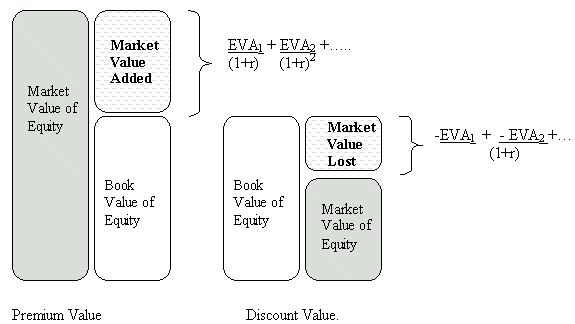|
"EVA - Demystified" - by Manish Daga * Introduction The aim of any organization is to maximize the wealth of the shareholder, who own the organization and expect good long-term yield on their investment. This goal has often been ignored or at least misinterpreted. Earnings per share and Return on investment are used as the most important performance measures, although they do not theoretically correlate with the shareholder value creation very well. Stern Stewart & Co. pioneered the development of Economic Value Added (EVA) framework, which offers a consistent approach to setting goals and measuring performance, communicating with investors, evaluating strategies and allocating capital. EVA as a value based performance metric seeks to measure the periodic performance in terms of change in value. Maximizing EVA means the same as maximizing long-term yield on shareholders' investment. It is the measure that captures the true economic profit of the organization. Economic Value Added Defined Economic Value Added (EVA) may be defined as the net operating profits after tax minus an appropriate charge for the opportunity cost of all capital invested in an enterprise. Thus, EVA = Net Operating Profit after tax - Weighted Average Cost of Capital Weighted average cost of capital is defined as the cost of equity share capital plus the post tax cost of debt multiplied by the debt equity ratio. Cost of equity capital is the opportunity return from an investment with same risk as the company has. Cost of equity is usually defined with Capital asset pricing model (CAPM). The estimation of cost of debt is naturally more straightforward, since its cost is explicit. Cost of debt includes also the tax shield due to tax allowance on interest expenses. EVA can be rewritten as: EVA = (ROI - WACC) x CAPITAL EMPLOYED EVA captures the fact that equity should earn at least the return that is commensurate to the risk that the investor takes. In other words equity capital has to earn at least same return as similarly risky investments at equity markets. If that is not the case, then there is no real profit made and actually the company operates at a loss from the viewpoint of shareholders. On the other hand if EVA is zero, this should be treated as a sufficient achievement because the shareholders have earned a return that compensates the risk. Market Value Added Defined A return greater than the cost of capital adds to the value of the organization. Market Value Added for listed companies have been defined as the difference between the company's market and book value. In other words if the total market value of a company is more than the amount of capital invested in it, the company has managed to create shareholder value. If the case is opposite, the market value is less than capital invested the company has destroyed shareholder value. Market Value Added = Company's total Market Value - Capital invested And with simplifying assumption that market and book value of debt are equal, this is the same as: Market Value Added = Market Value of Equity - Book Value of Equity Book value of equity refers to all equity equivalent items like reserves, retained earnings and provisions. In other words, in this context, all the items that are not debt (interest bearing or non-interest bearing) are classified as equity. Thus market value added tells us how much has been added or reduced from the shareholder's investment. If a company's rate of return exceeds its cost of capital, the company will have a positive MVA and will sell on the stock markets with premium compared to the original capital. On the other hand, companies that have rate of return smaller than their cost of capital sell with discount compared to the original capital invested in company. Thus whether a company has positive or negative MVA depends on the level of rate of return compared to the cost of capital. All this applies also to EVA. Thus positive EVA means also positive MVA and vice versa. Market Value Added = Present value of all future EVA This relationship between EVA and MVA has its implications on valuation. By replacing the market value added with the present value of future EVA we can obtain the value of the company as: Market Value of Equity = Book Value of Equity + Present value of all future EVA Diagrammatically it can be shown as:
Advantages of Economic Value Added
Pitfalls of EVA EVA is a value based measure, and it gives in valuations exactly same the answer as discounted cash flow, the periodic EVA values still have some accounting distortions because EVA is after all an accounting-based concept, suffering from the same problems of accounting rate of returns (ROI etc.). In other words the historical asset values that distort ROI do distort EVA values also. EVA is the excess of ROI over WACC multiplied by the capital employed and thus as the ROI suffers from serious limitations of wrong periodizing and distortions caused by inflation the same gets incorporated in EVA also.
Implications EVA is based on the common accounting based items like interest bearing debt, equity capital and net operating profit and it is usually always good when EVA increases and always bad when EVA decreases. Industries like telecom, forestry products, pharmaceuticals, semiconductors etc are the ones with very cyclical investments (not smooth over the years) and/or industries with very long investment horizon suffer most from the pitfalls of EVA. But even in such industries the EVA financial management system can be successfully implemented with changes in the accounting procedure like changes in depreciation schedule. In other industries with a lot of current (instead of fixed) assets and with short investment period EVA can be easily used to the benefit of the shareholders. * Contributed by - |

